 |
|
|

BOOK SALE (UPDATED) - I'm selling off some scholarly books via Amazon Marketplace. Have a look!

|
2007
February
28
|
Dueling videos at Wal-Mart
I am not yet an enemy of Wal-Mart, but they're increasing their efforts to make me one.
I'll overlook the episode, about 10 years ago, when they ejected me from a store for
writing down the prices of various kinds of film.
I suppose they thought I was working for a competitor — but all I was doing was
planning my own purchases. Weird.
Today I bought gasoline from them and was subjected to two video screens blaring commercials,
both with loud audio, both attached to the gas pump but showing completely unrelated programs.
One of the screens had an "audio off" button that I eventually found.
The other kept on blaring.
I suppose Wal-Mart expects its unsophisticated customers to say, "Gyaaaa-lee, look at all them
TV's!" and give the dueling videos their rapt attention.
The gas pump was also bedecked with advertisements for all kinds of tobacco products — not just
logos, but particular items with prices.
This is the 21st Century, and most merchants are scaling back tobacco.
Wal-Mart is shoving it in our faces. How long until they find themselves on the wrong
end of a lawsuit from a lung cancer victim?
Permanent link to this entry
1959 New Jersey runaway locomotive
During some idle moments in the library after work today, I pulled out Popular Science Monthly,
1961, and reread an article that I must have read as a boy, because it was familiar.
It was about the 1959 New Jersey runaway locomotive incident (about which I can find
absolutely nothing on the Web).
Late one night in 1959, a locomotive pulled out of a New Jersey railroad yard, running at full
throttle with no lights on. It ran right over a derailer (the gadget they put on the tracks to
keep unattended cars from rolling away) and landed right back on the tracks.
For the next half hour or more, dispatchers busily switched it from track to track
to prevent collisions and tried to figure out exactly what was going on.
There was constant danger of a deadly collision.
At one point the dispatchers considered sending the runaway locomotive
over an open drawbridge and dumping it into the water.
But they didn't want to risk killing the crew.
Although most of the crew was known to be safely at home, the engineer initially
couldn't be located, and they thought he was in the locomotive and had
been hijacked.
The winning tactic was to chase it with two more locomotives (one ahead and one behind),
match speeds, couple, and then climb into it and shut it down. This was accomplished, and
there turned out to be no crew in the runaway locomotive at all.
The mystery of why it ran away was
never solved.
But at least it was recovered with no one injured and not even any serious
damage to property.
Only one solution to the mystery occurs to me.
Someone started up the locomotive, set the throttle and other controls,
drove it for a while, and jumped out, presumably into water, presumably to his death.
Permanent link to this entry
Miscellany
The unemployment rate among the Covingtons continues to drop.
Just a few hours before she was to start a different job, Cathy was snapped up
(at appreciably higher pay) by the same company that
recently hired Melody. It's a temporary job; she'll resume classes in May.
Pete Albrecht advises me that
American-made recording tape
is now
truly defunct.
Tape is apparently still being
made in Europe, though.
This eventful month is finally over. See you in March!
Permanent link to this entry


|

|
2007
February
27
|
Have the bones of Jesus been found?
Well, The Discovery Channel,
which has catered to the gullible before now,
wants you to think they have.
If so, they prove there was no Resurrection and Ascension.
But wait a minute. If those are the bones of Jesus Christ, why did
it take 2,000 years to find them? Plenty of people have wanted to
disprove the Resurrection before now.
And how do you know this wasn't one of the other
people named Jesus (Yeshua), a very
common name?
(Many of whom had fathers named Joseph, another very common name.)
It's like finding the grave of "John Smith" and concluding it must
be the John Smith who led the Jamestown colony in 1607.
And why are we hearing about this from a movie producer,
rather than from scholarly archeological journals?
It's really rather silly to assume that Jesus' followers knew nothing
about him and that modern guesswork is preferable!
People will ask, "Why are you criticizing this movie when you haven't even seen it?"
For two reasons:
- If it's indeed a hoax (or irresponsible sensationalization), I don't want to
throw money at it. The movie was apparently made to make money.
- High-budget movies are not the normal place to find reliable archeology.
Expert critics will quickly tell me more than the movie will.
I actually don't need to see it in order to find out what its claims are
and how they are regarded by experts.
Permanent link to this entry
The Intellectual Diversity in Higher Education Act
Is this a good piece of legislation? Read it and decide for yourself.
If it passes, this bill will set some policies for the Georgia state university system,
of which I am an employee.
The goal is to keep professors from "indoctrinating" students with their opinions or
discriminating against students who hold different opinions about controversial subjects.
My take? The policies are mostly reasonable, but I'm not sure they need to be imposed
by legislation.
I'm not sure what kind of "indoctrination" they're trying to prevent. I can think of
these possibilities:
- Religious;
- Anti-religious;
- Political;
- Other controversies, e.g., in areas of scholarly study.
I think the middle two are what the legislators have in mind.
There is certainly a tradition, in academia, of
professors advocating atheism or left-wing political causes in the classroom.
On the one hand, I think this is generally unprofessional.
But on the other hand, if it's germane to the course, why shouldn't professors
tell us where they're coming from? Provided, of course, they don't mind their
colleagues and department heads knowing what they're doing.
The first one is probably a straw man.
As a Christian, I consider it my duty not to use my classroom as a platform
for anything other than the subject I'm being paid to teach.
And in my subject, Christianity just doesn't come up.
If I were teaching philosophy or literature, it would come up more often, and then
I ought to identify myself truthfully rather than pretending to be a nonbeliever.
Even then, though, I think I'd have a duty to let my students know about
widely held positions other than my own.
The last one is where the legislation could backfire.
My students rely on me to give them my opinions about scientific controversies.
If I had to give equal time to 20 different theories of computational linguistics
rather than favoring the ones I think are right, my courses would be hash.
Permanent link to this entry


|

|
2007
February
26
|
Miscellany
Remember the privately-issued Liberty Dollar?
The Feds have decided it's illegal.
The reason? It looks like an imitation of a U.S. coin.
If it were a merchant's token, it should say who issued it, but it just says "USA."
How many legislators does it take to change a light bulb?
Both in California and in Europe, there are proposals to
ban incandescent bulbs and require replacing them with compact fluorescents.
I think compact fluorescents are a Good Thing, but they're not a perfect replacement
for the old kind of light bulbs.
What about light fixtures that can't hold the new kind of bulbs?
Or photographers' floodlights? (You can't get good color with a fluorescent bulb.)
Or a zillion other special uses?
Read these comments.
Permanent link to this entry


|

|
2007
February
25
|
No matter how I send e-mail, it's wrong
Major revision 8:30 p.m. Feb. 25.
Perhaps the worst thing spammers have done to the Internet is that now
you're not getting all of your e-mail and neither am I.
Heavy spam filtering is necessary, and the filters are sometimes wrong.
This afternoon I sent Pete Albrecht a message and it didn't reach him.
Fortunately (?) it didn't just disappear, either.
I got back an automatic reply with this error message:
----- The following addresses had permanent fatal errors -----
...
(reason: 554 Message not allowed - UP Email not accepted for policy reasons.
Please visit http://help.yahoo.com/help/us/mail/defer/defer-04.html[120])
"Aha!" said I, "They think I'm a spammer. And why do they think I'm a spammer?
Because my 'From' address doesn't match my outgoing mail server."
I should explain. I receive e-mail on a Sectorlink server (www.covingtoninnovations.com).
But I have Bellsouth DSL service at home, and Bellsouth blocks all outbound e-mail (SMTP)
connections to servers other than its own. So my mail goes out on Bellsouth even though it
has a Covington Innovations return address.
That's exactly the kind of trickery spammers use, when, for instance, they claim to
be Paypal and actually transmit from flybynight.bozonet.cn or something.
Bellsouth's restriction is well-intentioned.
The intent is that when Granny clicks on the nice "electronic greeting card" that is
actually a spam virus, Bellsouth won't let it send spam. And for that purpose Bellsouth has to
control all e-mail going out from its network.
Anyhow... I was in an online chat session with Bellsouth support for half an hour, and it was like
doing battle of wits with an unarmed opponent. They answered a different question than I asked,
and then they hung up on me when I said they had it the wrong way around.
Then, in a matter of minutes, Sectorlink came through. They have a secret port (other than 25)
through which I can get into their server and send properly authenticated e-mail.
So I set up my mail client to do so.
Today's score: Bellsouth 0, Sectorlink 1.
But that didn't solve the problem. Even though I'm now sending e-mail with perfectly kosher return
addresses and headers, I still can't send my original message to Pete (which contains graphics and HTML).
Apparently, his ISP is sure it's spam.
It's time to re-engineer the Internet and also to get serious about prosecuting spammers.
Spam constitutes 90% of the world's e-mail.
If saboteurs were using 90% of our highways or telephone lines, we'd go to war.
But legislators think the Internet is some kind of la-la land that doesn't matter.
Permanent link to this entry
Better listening
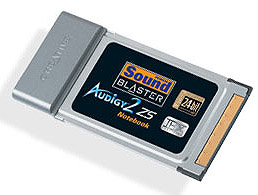 Yesterday I realized I hadn't been listening to enough music lately, and there were two main reasons.
I sit and work at my University-issued Dell D610 laptop, which, for all its other virtues, has a
rather disappointing internal audio system. There are lots of spurious pops, clicks, and gurgles
because it isn't well isolated from sources of electrical noise.
Yesterday I realized I hadn't been listening to enough music lately, and there were two main reasons.
I sit and work at my University-issued Dell D610 laptop, which, for all its other virtues, has a
rather disappointing internal audio system. There are lots of spurious pops, clicks, and gurgles
because it isn't well isolated from sources of electrical noise.
Also, my good headphones — the
Sony 600 set that I got last year —
are just too heavy for prolonged use.
Both of these problems can be solved by shopping, so, like a good American, that's what I went and did,
with Melody in tow as advisor and confidante.
I came home with a
PCMCIA (PC Card) Sound Blaster
to use in the slot in the laptop.
This is a really good audio system, conveniently packaged.
I've used Sound Blaster Audigy cards in other machines and always been pleased.
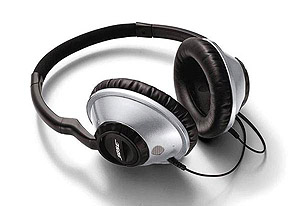 After considerable debating with myself, I also got some
Bose Triport around-ear headphones.
These are the only around-ear, fully noise-blocking phones I've found that can be described as
truly lightweight.
After considerable debating with myself, I also got some
Bose Triport around-ear headphones.
These are the only around-ear, fully noise-blocking phones I've found that can be described as
truly lightweight.
I debated with myself because these Bose phones have a couple of drawbacks.
Reviewers on Amazon say they're fragile and likely to break in normal use.
(Bose gives only a 1-year warranty.)
They don't fold up for transport.
And Bose doesn't release any audio specifications (driver size, frequency response, etc.).
Some reports say these phones have their own distinctive acoustics and are not good for
audio mastering, where you want to predict how things will sound on other people's stereos.
For this reason, I seriously considered the
Sony 777
as an alternative but ended up with Bose anyway.
I think this Sony product was designed to compete head-on with the Bose Triport,
and if I could have tried it on, I might well have bought it; it looks solidly built
and might be as comfortable as the Bose.
Reportedly, the best-sounding headphones in this price class come from
Grado,
but they're not as comfortable to wear, nor do they block outside noise.
The Bose headphones sound great.
Reportedly, they contain 3 drivers on each side, not just one.
I certainly have no quarrels with the sound quality, and the construction seems
rugged enough; no worse than Walkman-style headphones.
It's just that if you see the big earcups and treat them as if they were a pilot's
headset, they'll probably break.
But the PCMCIA soundcard is what's really worthwhile. It's quiet and effective.
It does have a baseline hiss that is audible in the headphones, so I'm thinking of
inserting an inline attenuator.
And of course I also found
something
interesting to listen to.
Permanent link to this entry


|

|
2007
February
24
|
Electronic bank transfers
Regarding our experience
the other day, Doug Downing points out a banking regulation that gives
the bank only 1 day to clear a check on another local bank.
So if we had carried them a piece of paper, they would have had to clear it right away.
Why the 3-day delay for an electronic transfer?
Personally, I think it's a scam. Melody tells me she was advised it would take 3 days, and she
could have paid more to have it done in one day. Electronic transfers don't take time.
The only motive for the 3-day delay must be that the bank wanted to put our money somewhere for
three days and earn interest on it.
Permanent link to this entry
Brain science, tobacco, and law
Tobacco damages the brain: Confirmed by
recent research.
Like other strongly addictive drugs, nicotine causes changes in brain chemistry that
may be permanent. It's not just a matter of will power. It's more like having had a leg
cut off; it's not going to grow back. We probably have a substantial number of people who,
if they succeed in giving up smoking (as I hope they do), will
require nicotine patches or gum for the rest of their lives. (At whose expense?)
BTW, I assume everyone realizes by now that it's uncontroversial that the tobacco industry
lied to the public. The connection between smoking and lung cancer was discovered by the
Germans in 1929, rediscovered in Britain around 1950, and then actively concealed by the
tobacco industry until the Surgeon General's report in 1964. From 1950 to 1964, and for as long
afterward as they could get away with it, the tobacco industry spouted misinformation and used
propaganda tactics to try to get people not to believe the results of medical research.
I've seen some of their internal documents myself, in which they plot strategy to confuse
and mislead the public. Under the terms of the Master Tobacco Settlement, these documents
were made public. Some of them are being studied by our
linguistics graduate students as examples of lying language.
Meanwhile, if you don't look too closely, it looks like the tobacco industry won
a recent Supreme
Court case. The Court ruled (correctly, in my opinion) that a jury can't award punitive damages for
harm done to people who aren't parties to the case. In essence, the Court ruled that if you want a
class action verdict, you have to bring a class action suit. I think that's correct, even if it
gets Philip Morris off the hook temporarily. Just bring in a bigger hook...
I fully expect product liability law to kill off tobacco, and I'm wary of any kind of
regulation that might ultimately limit tobacco manufacturers' responsibility for their actions.
For years the tobacco companies have been arguing that if they display the government health warning,
they can't be blamed for the harm done by their products. Bah humbug.
Permanent link to this entry


|

|
2007
February
23
|
Canon's next generation of DSLRs
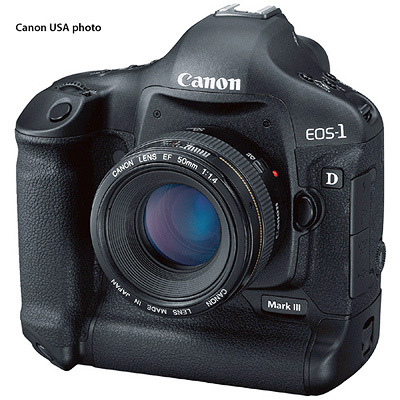
Canon's new EOS 1D Mark III is not just better than film,
it's a lot better than film.
It features a new sensor with lower noise than any of its
predecessors; 14-bit digitization (instead of 12-bit);
a 3-inch LCD screen (the biggest yet);
and live focusing, a feature formerly offered only
on Canon's astrophotography model, the EOS 20Da.
It's $4000, but we can expect the same technology to trickle down
to entry-level DSLRs very soon. I want one! (The trickled-down version, that is.)
Canon press release here;
product web page here.
Permanent link to this entry
Why FSSM32.EXE goes to nearly 100% CPU
A problem with F-Secure Antivirus 6.02
My investigations with Process Explorer have paid off.
I now know why, on two different afternoons, my computer has gone into slow motion
as F-Secure Antivirus (FSSM32.EXE) consumed nearly 100% of the CPU cycles.
As a background process, F-Secure slowly scans your whole disk for viruses.
Our local configuration tells it not to scan .ZIP files or several other types.
But it has to scan .EXE files, since they are executable programs and are the
most likely location for a virus.
The problem is that some .EXE files are large self-extracting ZIP files.
The install file for an old version of JBuilder is an instance of this.
When F-Secure hits one of them, it does not remain well-behaved. Instead, it starts
taking nearly all the CPU cycles in a misguided attempt to finish.
That is simply not what F-Secure should do.
Primum non nocere. The first thing that we expect of our antivirus software
is that, if it hasn't actually found a virus, it shouldn't disturb our productive work.
Slogging through a self-extracting ZIP may be hard work, but it should still be done in
the background, just like the rest of the virus scanning.
Permanent link to this entry


|

|
2007
February
22
|
Unimpressed by this newfangled stuff
We have checking accounts in two banks.
On Monday evening we paid Bank of America $3 to transfer some money
to our SunTrust account, thinking the electronic transfer would be
faster than carrying a check to the bank.
Nothing doing. Bank of America showed the funds departing on February 20,
but not until today (Feb. 22) did they arrive at SunTrust — and even so,
they're shown as "pending," not "collected."
Economically, the effect is different than with a paper check.
The old way, the money would have temporarily shown up in both banks
(probably for just a day, now that checks clear electronically).
The new way, the money is in limbo for two days.
The new method keeps the banks from having to take a risk. I suppose that's
why they like it.
But where was my money during the missing 48 hours?
Happy birthday, Cathy! Unlike our funds transfer, you are present and accounted for...
Permanent link to this entry


|

|
2007
February
21
|
 Miscellany
Miscellany
At the right is the scariest thing I've seen lately,
on the web site of a British newspaper.
No, they're not having hyperinflation over there.
Those rates are just as unreasonable in their money
as they would be in ours.
But at least their government makes the lenders
disclose the rates prominently in the ad.
One of the myths of modern times — something everybody "knows" but it isn't true —
has to do with cave men.
Was there ever a time when most people lived in caves?
No.
Did a few people live in caves in ancient times?
Yes, and because caves preserve their contents, we know more about a handful
of cave dwellers than about everybody else.
Well, there are still cave men. That is, there are still people
who live in caves.
And why not?
Caves are handy, if they're the right size and conveniently located.
Prime naturally-occurring real estate.
Here's a good tutorial on
surface-mount soldering with hot-air apparatus.
And everybody needs to know about the
sunk cost fallacy
(or fallacy of not ignoring sunk costs),
sometimes known as the error of throwing good money after bad.
The key idea is that you don't have to keep going down a path just because you've started it.
You don't have to finish everything you've invested resources in.
Naturally, we benefit from having a bias that inclines us to finish what we've started,
but sometimes you have to have the good sense to bail out.
The sunk cost fallacy is what makes gamblers and investors lose all their money;
they won't quit when they're only moderately behind.
Permanent link to this entry


|

|
2007
February
20
|
Arthur Christian
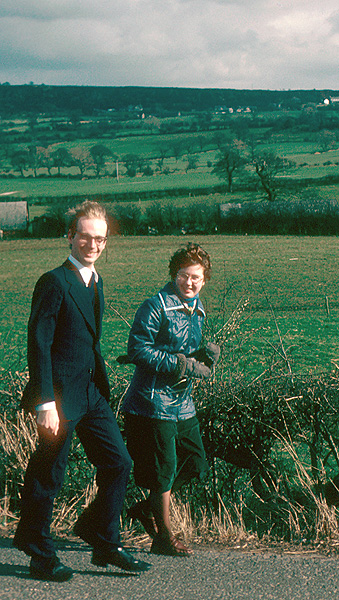
 One of my best friends from Clare College
died this morning of lung cancer, even though he had never smoked.
Previously, he had courageously rehabilitated himself after a stroke.
One of my best friends from Clare College
died this morning of lung cancer, even though he had never smoked.
Previously, he had courageously rehabilitated himself after a stroke.
Arthur Christian was an electrical engineering student in his last year when
I was at Cambridge in 1977-78. He deserves much of the credit for rekindling my
interest in electronics, introducing me to TTL ICs and solderless breadboards,
and thus indirectly launching a substantial part of my career.
Arthur was active in the Church of England, mainly as a church organist, and
often delivered a rousing performance of "Purcell's Trumpet Voluntary, by
Jeremiah Clarke" on the organ in Clare College at the end of the morning service.
(It quickly became one of my favorite pieces of music, and Melody and I used it
as the processional at our wedding. You can hear part of it
here.)
I spent Easter 1978 with Arthur and his parents and sister in Congleton, Cheshire.
The drive up included spectacular views of limestone gorges in Derbyshire
and visits to quaint towns such as Worksop (that's the correct spelling).
Arthur and his sister Fran (whom you see in the picture) took me to
Macclesfield Forest with the remark, "This is real
Lord of the Rings country," to which I replied,
"Congratulations, you've taken me to the only place in Britain
that looks exactly like North Georgia!"
And I had a delightful visit with
Arthur and his wife Bey when they were newlyweds in High Wycombe, Buckinghamshire,
in 1981. At the time they had a new color TV that would run BASIC, a spinoff of Arthur's
employer's experiments with microprocessors in TV sets.
Cathy and I visited Arthur, Bey, and their children in 2000
at their home in Mursley, a delightful village
near Milton Keynes. Arthur was
operating a consultancy which became Ajutel.
Melody and I met them for dinner in Chinatown (London) in 2001.
And now Arthur's gone.
He will be missed.
Permanent link to this entry
Process Explorer solves FSSM32.EXE mystery (at least partly)
I run a version of F-Secure Antivirus that is highly customized and centrally
managed by the University of Georgia.
Periodically, it slows down my computer; FSSM32.EXE (the process that virus-checks
every file when you open it) goes to near 100% CPU utilization for several minutes
or more.
(To see what processes are running and how much of the CPU they're using,
press Ctrl-Alt-Del and choose Task Manager.)
Well... Today I got a lot of important clues from
Process Explorer,
a free utility that is Task Manager's big brother.
Process Explorer can tell you what files a process is reading or writing.
To achieve this, you'll probably need to open Process Explorer with administrative
privileges. (Just right-click on it, choose Run As, and give the admin user name
and password.) Then go to the menus, turn on the lower half of the screen, and choose
"Handles" as the information to be displayed there.
Then click on the miscreant process, sit back, and watch the action.
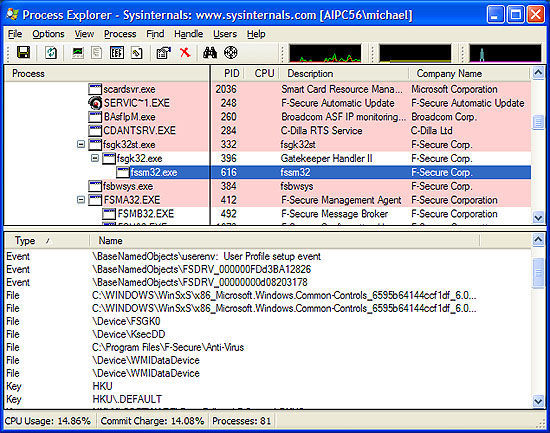
In my case, FSSM32.EXE was slowly slogging through some archived ZIP files that I hadn't touched
in years. (That's not shown in the picture above; the picture was taken on a different computer.)
This leads to 2 possible explanations:
— Maybe F-Secure was doing a full scan of my hard disk, for reasons known only to itself,
at a time very inconvenient to me.
— Or maybe some other kind of disk scan was running — maybe the Indexing Service —
and F-Secure was checking everything it tried to read.
Inquiring minds want to know. And I'm going to find out, by using Process Explorer to find out
what other processes, if any, had the same file open.
Permanent link to this entry


|

|
2007
February
19
|
One more...
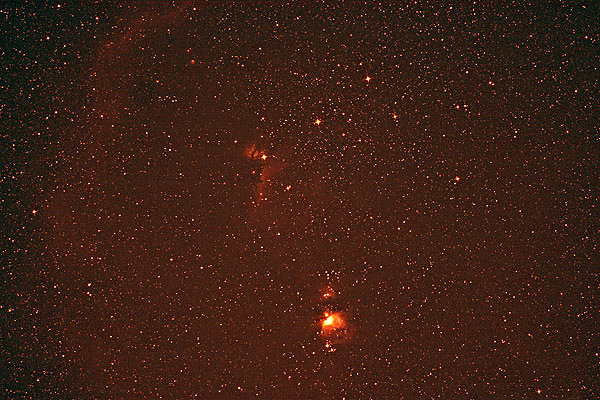
Click picture for larger image
Here is a better rendition of the picture of southern Orion that I showed you a few
days ago.
This is the full frame rather than a cropped portion.
It is a stack of four 6-minute exposures through a 180-mm f/2.8 lens and a B+W 091 red filter,
calibrated against two dark frames and two flat-field frames.
The flat fields were taken by holding a light box in front of the lens; their purpose
was to record, and later correct for, vignetting and dust on the sensor.
Despite being presented in color, this is essentially a black-and-white picture.
Not all the nebulae in it are really red.
What's crucial is that, at these deep red wavelengths, there is almost no light
from streetlights. Accordingly, I was able to take this picture under magnitude 4.5 skies.
Permanent link to this entry


|

|
2007
February
18
|
Oddments
I'm busy writing things other than Daily Notebook entries, but here are a couple of
curiosities from recent days.
Bogus pianist: The greatest English piano player of modern times
(if you believe some critics) turns out to be
fake or nonexistent.
All the CDs of the late Joyce Hatto are turning out to be copies of other
pianists' CDs.
Pitch Drop Experiment:
If you like slow action (slower than watching paint dry),
click here.
Permanent link to this entry


|

|
2007
February
17
|
Orion in Hydrogen-Alpha
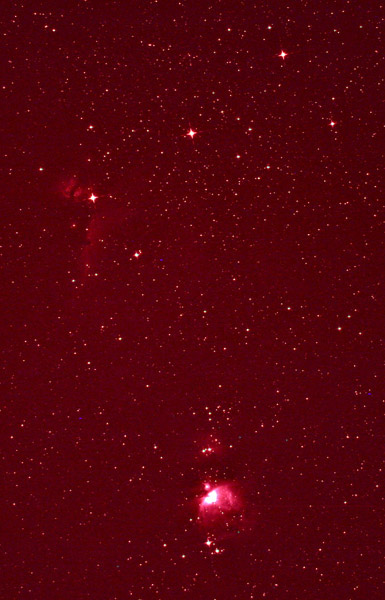
This is what southern Orion looks like at the wavelength of hydrogen-alpha (656 nm).
This is a very rough presentation of an image that I plan to process quite a bit more.
The finished product will not have the "hot pixels" that show up as blue specks here.
This is a single 6-minute exposure with a Canon EOS 20Da and a B+W 091 deep red filter.
It shows only a narrow range of wavelengths from about 620 to 660 nm.
You can see the Orion Nebula at the bottom, and at the upper left, the Flame Nebula
and the Horsehead (which is the notch in the ribbon hanging down).
At these wavelengths, the sky above my house is fairly dark.
To the human eye, the sky was far from dark and the magnitude limit was 4.5 at best.
Permanent link to this entry


|

|
2007
February
16
|
Metzger vs. the Jesus Seminar
Prominent New Testament scholar Bruce M. Metzger
has died at age 93.
He led efforts to make the original Greek text of the New Testament widely available
and was also prominently involved in producing the Revised Standard Version.
I went to a lecture that he gave about ten years ago. Two things stand out in my memory.
People were bringing Bibles for him to autograph (which makes sense if they were editions
he worked on, but looked a bit odd at first sight).
And, in the course of a lucid lecture on Bible translation, he dismissed
the Jesus Seminar as "not exactly a work of scholarship"
(his words), merely an exercise in circular reasoning.
You'll recall that the Jesus Seminar claims to have discovered that Jesus didn't say or
do most of the things attributed to Him.
How did they discover this? By assuming it in advance.
They set out their presuppositions and accepted only the parts of the Gospels that fit them.
Metzger's dismissal of the Jesus Seminar carries all the more weight because Metzger himself
wasn't a fundamentalist or hyperconservative (though he was a solid Christian believer).
So he's not one of the people the Jesus Seminar set out to bash — he's the kind of
person from whom they expected support.
Permanent link to this entry


|

|
2007
February
15
|
Full civil rights for clones
(and test-tube babies too)
I'm opposed to the cloning of humans, but it's probably going to happen, at least on a small
scale, and when it does, I'm ready to defend the civil rights of people who come into existence
by cloning.
The public seems ready to treat human clones as a slave class and to assume that they won't have
minds or souls of their own. Nonsense! They'll be perfectly normal human beings, and
they won't come out of giant Xerox machines — they'll have to grow in wombs, be born, and
grow up like the rest of us.
Human clones already exist in nature. They're called identical twins.
And nobody claims that identical twins aren't fully human. (One of them is Melody's mother!)
If artificial cloning is ever done, the result will be lots of identical twins, or triplets,
or quadruplets, or what have you.
There's already a human-rights issue with test-tube babies conceived from donor sperm.
In general, such people can never find out who their biological father is,
and
they're starting to complain.
That's right: the first generation of anonymous-sperm-donor babies are now adults,
and some of them are complaining (rightly I think) that their human rights have been violated.
They're even afraid of being bamboozled into marrying their own half-brothers or half-sisters,
simply because there's no way to know!
In my opinion, some things should be
done the old-fashioned way. Having children is one of them.
Permanent link to this entry


|

|
2007
February
14
|
Did someone name a star after you for Valentine's Day?
If so, it was a thoughtful gesture, but
read this.
The names "sold" by
International Star Registry
and other organizations
are completely unofficial.
Astronomers will never use them.
Astronomers don't even have access to them.
A while back I was contacted by a man who wanted me to take a picture of a star that had been
"named" in honor of his deceased brother.
I suggested that it would be much easier to retrieve an existing
Digitized Sky Survey
image centered on his star, so that's what he asked me to do.
Smooth sailing, right? No. All he had was a set of coordinates with no date.
I tried the two standard epoch dates (B1950.0 and J2000.0) and didn't hit a star
brighter than 17th magnitude either way.
A bit of basic astronomy: You haven't identified a star unless you have coordinates and
the date (epoch) of those coordinates and at least a bit of physical information, such
as the brightness or spectral class.
[Feb. 15:] Although parts of their web site weren't working when I looked, it appears that the
International Star Registry does provide the star magnitude (brightness) and even a
location chart. They are also quite explicit that astronomers do not use their star names,
and they even allow customers to return their product if not satisfied.
If you have been the recipient of a named star, and you want a picture of it,
contact me. Just understand that the name will never be used by astronomers; they will
never even hear about it.
Permanent link to this entry


|

|
2007
February
13
|
Ko-duck?
Kodak's new logo is  . .
Their a looks awfully like the phonetic symbol for
schwa (the central vowel sound).
So do they want us to pronounce it "Ko-duck"?
At least they're not like cheap perfume companies that
décôràtë èvéry wörd
with meaningless accent marks.
Permanent link to this entry
One more thought about DSLR modification
My correspondents tell me that the best amateur astrophotos are always taken with modified DSLRs,
not unmodified ones.
To this I reply two things:
(1) The best-equipped photographers are also the most skilled, and they are the most likely to have
modified cameras, which definitely have an edge in some situations but not all.
(Also, the widespread belief that modification is necessary has led all of the most serious
astrophotographers to get modified cameras. There's a circular effect here.)
(2) The best amateur astrophotos are not the only kind that interest me.
My hobby has always been easy astrophotography.
I'm not lazy (well, maybe I am), but my main concern is cost-effectiveness.
If I can get 75% of the quality for 25% of the effort and expense, and the result is acceptable,
I'll jump at the chance.
(I'm going to hang onto this $2400 modified camera, no longer on the market,
as long as Canon will let me.
But I've had a lot of fun figuring out how to get nearly the same results with an $800 camera.)
Professional astronomers are concerned with cost-effectiveness, too.
Pretty pictures aren't the reason observatories are built.
Most observations are done with equipment that is just adequate for doing them.
Better equipment is used for the things that only it can do.
Permanent link to this entry


|

|
2007
February
12
|
More about DSLR modification
Yesterday's entry has created some controversy.
I'm not against modifying DSLRs. A modified DSLR does record hydrogen
nebulae better than an unmodified one.
But it is much worse for daytime photography, and my point is that if you
don't have the modification done, you can still do good astrophotography.
Let me refer you also to
this test,
by William J. Shaheen,
using images of the Rosette Nebula taken with a Nikon D50.
The first 2 pictures are the ones to compare.
The Rosette is much thinner than M42, so Hα sensitivity should be more
critical for photographing it.
But in fact most of it shows up even without the modification.
I have yet to find a good, fully documented instance of a nebula going from
invisibility to plain visibility as a result of the camera modification.
Permanent link to this entry


|

|
2007
February
11
|
What a difference H-alpha didn't make
Revised February 11 after original posting. See also Feb. 12.
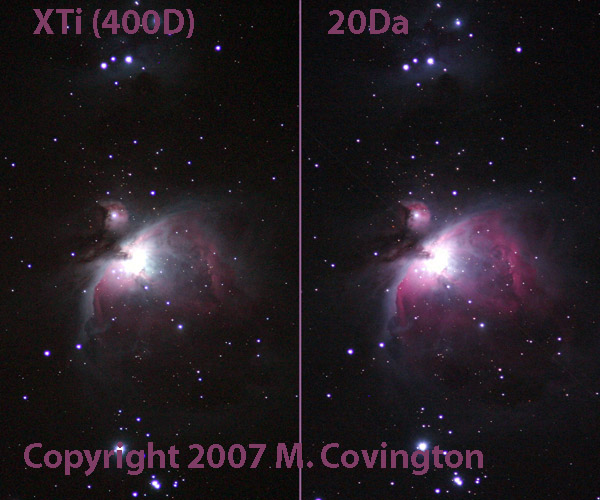
The word is out — mistakenly, I think — that DSLR cameras have to be modified to be
any good for astrophotography. The modification consists of removing the infrared-blocking filter
and replacing it with a different one that transmits more hydrogen-alpha (Hα) light.
Canon made one such modified camera, the EOS 20Da, although nowadays, the modification is
normally done by third parties such as Hutech.
How much difference does it make?
In the pictures above, not a gigantic amount, though there is certainly some.
The right-hand edge of the nebula is more representative of
how thinner nebulae would be rendered; note how much brighter it appears with the 20Da.
Note added Feb. 27: It has been determined that the filter in the Canon 20Da is not fully transmissive at Hα.
Independently modified DSLRs are somewhat more sensitive to that wavelength.
The pictures are of the Orion Nebula, which is bright in Hα.
Both are 3-minute exposures with a 300-mm f/4 lens and 1.4x teleconverter
(giving 420 mm at f/5.6).
There is more red in the second picture, and more of the nebula is visible,
but the difference isn't gigantic.
The pictures were processed with Photoshop to make them match in overall
contrast and color balance. Before processing, the conventional camera (XTi) showed
considerably more of a brown background from nearby sodium-vapor streetlights.
Perhaps the modified filter in the 20Da cuts that particular wavelength.
But Photoshop shouldn't affect how much of the nebula you can see. The two cameras
picked up almost the same amount of detail, except for the thinnest areas.
Note that the Orion Nebula is dense and strongly photoionized.
Published spectroscopic data indicate that Hα is more predominant in thin, faint
nebulae, which resemble only the outermost regions of the Orion Nebula.
Is the 20Da a great camera? Yes.
Is the modified camera better? Yes.
But is filter modification necessary for serious astrophotography?
In my opinion, no. Canon's literature says the modification increases Hα sensitivity 2.5x.
In photographic terms, that's about 1.3 stops, which is significant but not drastic.
The bottom line? DSLRs already see Hα a lot better than most color films do,
and the same is true of the blue lines of Hβ and OIII,
which fall in a gap in the
sensitivity of color film.
Nebula photography with unmodified DSLRs is quite practical.
See also the remarkable nebula photos taken by
Malcolm Park
with an unmodified Canon EOS 30D.
Permanent link to this entry


|

|
2007
February
10
|
The Chrysler book
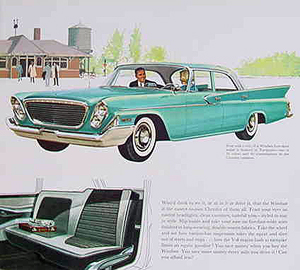
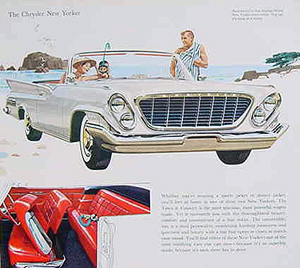
Above you see one of my most prized possessions when I was 4 years old.
No, not the cars — the booklet depicting them.
One afternoon in 1960, while we were visiting my grandparents, my mother and father
drove off to Statesboro
in their
1958 Oldsmobile
and came back in a new 1961 Chrysler Newport,
white with a red interior, with body styling more like a rocket than
anything I had ever hoped to ride in. And it was air-conditioned.
Along with the car came the booklet of which you see a couple of pages.
It showed all the Chryslers of 1961, together with an impressive diagram of the dashboard
and other technical information.
Around the middle of 1962, some cruel fate befell my Chrysler book.
As best I recall, one of my parents, without realizing what it was, cut a piece
off its cover to repair something else.
I was sad, and doubly sad when the dealer couldn't supply a replacement,
though I wish I'd kept the 1962 Valiant booklet I was offered in its stead.
Now it's 2007, and for Valentine's Day, Melody is giving me a replacement for the
booklet that was so sadly lost 45 years ago.
She got it from
Mobilia
Unlimited Auto Literature.
It turns out I'm not the only person who thought this booklet was a collector's item.
The Chryslers of 1961 were very distinctive — quite different from those of 1960 (horizontally arranged headlights)
or 1962 (no fins) —
and the booklet describes them in great detail.
In fact, the 1961 Chryslers are closely related to the last model of
DeSoto,
a brand that Chrysler discontinued the same year.
People traded cars more often back then.
The model years of my parents' cars, from my birth to my mother's death,
were 1958, 1961, 1964, 1969, 1973, 1979, and 1982.
My own personal cars (as distinct from the family minivans)
were 1973, 1976 (before graduate school),
another 1976 ("Melody's dowry"), 1982 (inherited from my mother),
1996, and that's all.
We do not yet have, in our household, a car made in the 21st Century.
Permanent link to this entry


|

|
2007
February
8-9
|
They have a name for it
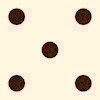 This geometric pattern — dots at the corners of a square and a dot in the middle — has
a name.
It's called a quincunx.
This geometric pattern — dots at the corners of a square and a dot in the middle — has
a name.
It's called a quincunx.
Today, the quincunx pattern (repeated) is familiar to landscape architects as a way to arrange trees or
shrubs.
In Roman times it was a way for legions to march.
It was also a standard representation of the number 5 or the fraction 5/12
(hence the name, from quinque unciae 'five twelfths, five ounces, five inches').
I've been down with a severe sinus infection for a few days;
that's why there's been so little here.
Now I'm on the mend but am behind with my work.
Permanent link to this entry


|

|
2007
February
7
|
International whimsy
What country has designated
a movie star as an official national symbol?
The same country whose
military flag used to be plain white.
I'm not kidding.
Permanent link to this entry


|

|
2007
February
6
|
Short notes
When the Chinese took a potshot at that junked weather satellite last month,
they created an orbiting trash pile
that endangers all other
satellites over a large area. Do a few more of those, and you could
end the Space Age.
Intel now makes quad-core Pentiums.
That's four CPUs in one. One to run Windows, two to run the antivirus, and one to run your programs.
(That's meant to be a joke, but I'm afraid it's close to reality.)
I've had a minor skin condition on my eyelids that required a trip to a specialist.
When the doctor examined me, he was wearing some very nice
magnifiers clipped to his glasses.
I asked him where he got them (expecting to hear that they cost $500).
No; they were these.
The price is right and the quality is excellent.
Pest of the week:
A
fake bank. It's not a bank. It may not be anything at all except a way to collect personal
financial information from would-be customers!
Permanent link to this entry


|

|
2007
February
5
|
Stephen R. Walton, 1955-2006
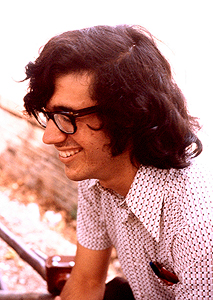 I've just received word that my old friend Steve Walton
has died. A detailed obituary can be seen
here (scroll down to it).
He was an astronomer at California State University, Northridge.
I've just received word that my old friend Steve Walton
has died. A detailed obituary can be seen
here (scroll down to it).
He was an astronomer at California State University, Northridge.
Steve was one of the ten Americans on the
trip to Australia and the Far East in 1973.
As far as I know, he is the only member of the group who is no longer alive,
although I have not kept up with all of them.
His web site is still up.
Also, here is an
insightful comment he recently posted in a political forum:
Yes, college professors are often liberal activists — but it is the liberal activism
of 20 or 30 years earlier; they are a trailing indicator, not the vanguard.
In the picture above, you see Steve in a park in Rome, Italy, in September of 1973.
I haven't actually seen him since the trip, but we corresponded in recent years.
Permanent link to this entry


|

|
2007
February
4
|
Blue nebula vindicated
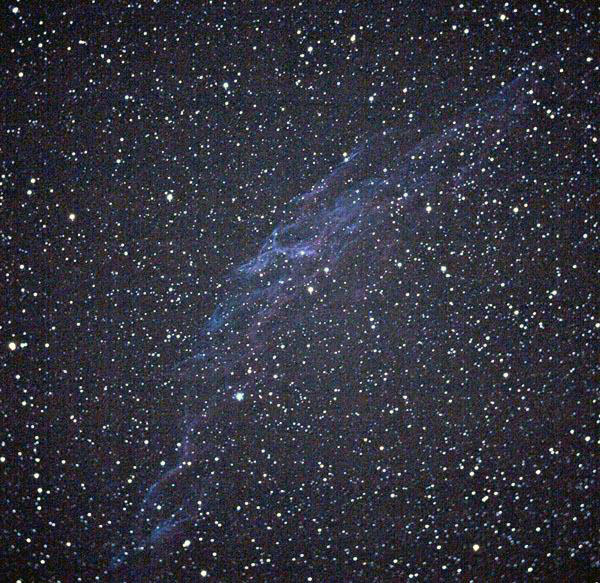
This is a picture of the Veil Nebula (part of the Cygnus Loop)
that I posted here back in October.
It's blue. Most published photographs of this nebula show it as red. What gives?
Well...
Being a cloud of ionized gas, the Veil Nebula has a line spectrum.
It gives off light only at a few selected wavelengths.
Among these are Hydrogen-Beta and Oxygen III in the blue part of the
spectrum and Hydrogen-Alpha in the deep red.
Color film responds to the spectrum in three bands, blue, green, and red,
and the blue and green bands don't overlap.
There is a slight gap between them.
This is not a problem in daytime photography
because bluish-green objects reflect both blue and green.
But the wavelengths of Hydrogen-Beta and Oxygen III fall between the blue
and green bands. Film almost doesn't see them at all.
Film does see the red light of Hydrogen-Alpha, at least if it's the right kind of film.
And that's why we have so many pictures that show the Veil Nebula brilliant red.
Now here's where the astrophysics gets interesting. According to Osterbrock and Ferland,
Astrophysics of Gaseous Nebulae, 2006, the brightest part of the Veil emits about 3
times as much light in the blue region of the spectrum as in the red region.
That's because it's very hot.
And it's still hot from the supernova explosion that created it, not from the effect
of any nearby star.
So it really is blue. And purple (a more even mix of blue and red) in the less heavily ionized
regions. My camera was telling the truth!
Permanent link to this entry


|

|
2007
February
3
|
Beware of WEB CALLING US WEB 800-6240914 CO
Looking at one of our credit card statements today, Melody noticed an
unauthorized charge of $25 on January 19 identified as:
WEB CALLING US WEB 800-6240914 CO
I dialed 800-624-0914 and found it to be Verizon Web Calling, apparently a legitimate
VoIP service. I only got an automated phone tree, not a human being.
I used Google and found out that other people have had spurious charges with the
same identifying number (examples here
and here).
Then I called the credit card issuer and got the charge removed.
Apparently this is the work of a thief who got my credit card number
and used it to open an account with Verizon.
Or perhaps someone who made up a number
that happened to be mine
and got Verizon to take it.
The incident is being investigated.
Of course, the reason I'm posting this blog entry is so that if other people
search for the same number, they'll find this.
Permanent link to this entry


|

|
2007
February
2
|
Carl and Jerry are back in print
At my instigation,
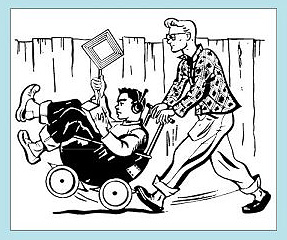 Jeff Duntemann has
anthologized and published
the
Carl and Jerry stories from Popular Electronics.
One volume is
available now, and the rest are coming.
Jeff Duntemann has
anthologized and published
the
Carl and Jerry stories from Popular Electronics.
One volume is
available now, and the rest are coming.
If you don't know about Carl and Jerry, you've missed an important part of circa-1960
American amateur electronics culture.
Let Jeff tell you what they were like.
You can read some of them on line
here,
here,
here,
here,
and
here.
There are also extracanonical Carl and Jerry stories written by other authors.
You can read part of one
here,
and Jeff has issued a challenge: Who wants to write more?
Technological didactic fiction is a genre that needs to be revived.
Speaking of didactic fiction,
who remembers Gus the mechanic,
who inhabited the pages of
Popular Science Monthly for more than 40 years?
Read some classics
here.
I particularly recommend this one.
Permanent link to this entry


|

|
2007
February
1
|
Iced?
The University is closed today because of a predicted ice storm, but we don't actually have
much ice, if any. The temperature has hovered near freezing while we've had several hours
of drizzle. Just a short distance north of us, travel is difficult.
(Note to my northern neighbors: We Southerners aren't afraid of snow. We don't get snow.
We do get ice storms, which, as you know, are much messier.)
[Note added Feb. 3: Some parts of our county got quite heavy ice. It was very irregularly
distributed.]
Permanent link to this entry
Miscellany
The post-shopping era: Yesterday, after dinner, I realized I was going to need some
electronic parts to complete an upcoming project. Rather than go rummage around a Radio Shack,
I logged onto Mouser, and to my surprise they were able to
ship the items almost immediately (within 45 minutes of my placing the order).
It cost me $6.25 to get them shipped the slow way; they'll reach me tomorrow.
[Well, now they're saying Monday, because the order was placed so late in the day.]
[But they made it Friday anyhow.]
If I'd wanted the items delivered this morning, I could have had them, for about $20.
There is no minimum order or service charge for small orders.
All this is worth thinking about. Supplies hand-delivered from a huge warehouse in Texas for $6...
no time spent shopping beyond the bare minimum to identify the items... no driving around
or waiting in line.
It reminds me of the way people got their groceries delivered in the 1920s.
In case you haven't noticed,
diskettes are obsolete.
We use networks, flash drives, and CDs to carry our files around.
Many of our files are too big to fit on a diskette anyhow —
even single pictures from a multi-megapixel camera.
That Boston bomb scare:
I'm sure one factor in Turner Broadcasting's fiasco yesterday is that
the cartoon character is making an offensive gesture.
That's probably what led people to conclude that it was a hostile device of some kind.
The ad didn't look like an advertisement. Nobody has said much about this.
Permanent link to this entry


|

|
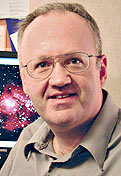









 Miscellany
Miscellany








 This geometric pattern — dots at the corners of a square and a dot in the middle — has
a name.
It's called a
This geometric pattern — dots at the corners of a square and a dot in the middle — has
a name.
It's called a  I've just received word that my old friend Steve Walton
has died. A detailed obituary can be seen
I've just received word that my old friend Steve Walton
has died. A detailed obituary can be seen

